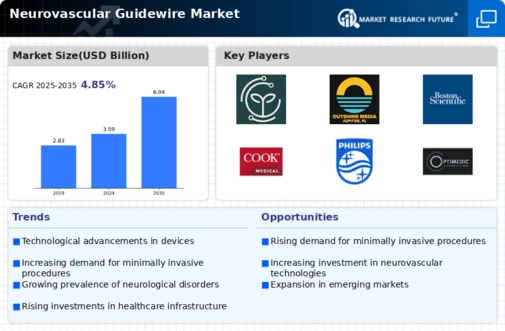Market Trends and Growth Projections
The Global Neurovascular Guidewire Market Industry is characterized by a steady growth trajectory, with projections indicating a market size of 3.59 USD Billion in 2024 and an anticipated increase to 6.04 USD Billion by 2035. The compound annual growth rate (CAGR) of 4.84% from 2025 to 2035 suggests a robust expansion driven by various factors, including technological advancements, increasing prevalence of neurovascular disorders, and rising healthcare investments. These trends indicate a dynamic market landscape, where innovation and improved patient outcomes are at the forefront of industry developments.
Technological Advancements in Medical Devices
Innovations in medical technology are significantly influencing the Global Neurovascular Guidewire Market Industry. The development of advanced guidewires, featuring enhanced flexibility, torque control, and biocompatibility, is improving procedural outcomes. For instance, the introduction of hydrophilic-coated guidewires has facilitated smoother navigation through tortuous vessels, reducing procedure times and enhancing patient safety. These advancements not only improve the efficacy of neurovascular interventions but also expand the range of treatable conditions. As a result, the market is likely to witness sustained growth, with projections indicating a market size of 6.04 USD Billion by 2035.
Rising Investment in Healthcare Infrastructure
The Global Neurovascular Guidewire Market Industry benefits from increased investments in healthcare infrastructure, particularly in developing regions. Governments and private sectors are focusing on enhancing healthcare facilities, which includes the procurement of advanced medical devices. This investment trend is particularly evident in countries with emerging economies, where the demand for neurovascular interventions is on the rise. Enhanced healthcare infrastructure not only improves access to neurovascular treatments but also encourages the adoption of innovative guidewire technologies. Consequently, this trend is expected to contribute to a compound annual growth rate of 4.84% from 2025 to 2035.
Increasing Prevalence of Neurovascular Disorders
The Global Neurovascular Guidewire Market Industry is experiencing growth due to the rising incidence of neurovascular disorders such as stroke and aneurysms. According to health statistics, stroke remains a leading cause of mortality and disability worldwide, necessitating advanced medical interventions. The increasing number of patients requiring neurovascular procedures drives demand for guidewires, which are essential for navigating complex vascular pathways. As the global population ages, the prevalence of these disorders is expected to rise, further propelling the market. This trend indicates a robust market potential, with the industry projected to reach 3.59 USD Billion in 2024.
Regulatory Support and Approval for Advanced Devices
The Global Neurovascular Guidewire Market Industry is positively impacted by regulatory support for the approval of advanced medical devices. Regulatory bodies are increasingly recognizing the importance of innovative guidewires in improving patient outcomes. Streamlined approval processes for new technologies enable manufacturers to bring their products to market more efficiently. This regulatory environment fosters innovation and encourages investment in research and development of novel guidewire solutions. As a result, the market is likely to expand, with manufacturers capitalizing on the favorable regulatory landscape to introduce cutting-edge products.
Growing Awareness and Education on Neurovascular Health
Awareness campaigns and educational initiatives regarding neurovascular health are playing a crucial role in the Global Neurovascular Guidewire Market Industry. Increased public knowledge about the symptoms and risks associated with neurovascular disorders leads to earlier diagnosis and treatment. Healthcare providers are also receiving training on the latest techniques and technologies, including the use of guidewires in neurovascular procedures. This heightened awareness is likely to drive demand for neurovascular interventions, thereby increasing the need for high-quality guidewires. As a result, the market is poised for growth as more patients seek timely treatment.





















